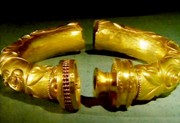|
Ulster's Most Famous Art Venues
Among the province's numerous art
galleries, the foremost arts centre is the Ulster
Museum, in Belfast, which is famous for its collections of Irish antiquities,
paintings and sculpture, including works
by Thomas Gainsborough,
Joshua Reynolds, J.M.W.
Turner, various Dutch, Flemish and Italian Old Masters, as well as
paintings by Irish artists like James
Arthur O'Connor, the Impressionist Roderic
O'Conor, Walter Osborne,
John Lavery, John
Luke and William Conor.
Other Belfast visual arts venues include the Naughton
Gallery at Queen's University and Gormley's
Fine Arts (Belfast & Omagh)
Cavan County Museum, Cavan town
The first council-funded museum in the Republic of Ireland, this award-winning
art museum and heritage centre presents a wide array of artifacts, paintings,
prints, drawing, miniatures and sculpture, featuring works by Irish and
UK artists.
Tyrone Guthrie Centre, Annaghmakerrig,
Co Monaghan
This unique venue situated in 450 acres of forest offers artists studio
space and accomodation for up to 12 months.
Ardara Heritage Centre and Art Gallery,
Co Donegal
Located on the south-west coast of Donegal, Ardara village has become
a centre for Donegal arts and crafts,
with a wide range of displays, workshops and studios.
Ulster Folk and Transport Museum
A faithful reconstruction of Ulster life in the early 1900s, including
exhibitions and displays of domestic and work life, rural and religious
interiors and artifacts, plus steam trains and a Titanic exhibition.
Other Notable Arts and Culture Centres
in Ulster
- Armagh County Museum in Armagh Town
- The Tower Museum, Derry City
- Enniskillen Castle and Heritage Centre, Co Fermanagh
- Saint Patrick Centre and Cathedral, Downpatrick, Co Down.
See also Art
schools in Ulster.
|
